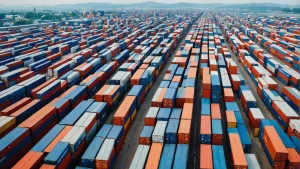Cross docking is no longer an option for your business; it’s an essential game-changer.
In the fast-paced world of business operations, demanding customers and higher delivery expectations require streamlined logistics, and cross-docking might be your golden answer. Defining a solution to contracting margins and extended delivery times, cross-docking is an undisputed game-changer. Uncover how streamlining your outbound logistics processes through cross-docking can revolutionize your delivery efficiency and customer satisfaction rates.
Ever been in an airport, watching luggage swiftly change planes without entering the main terminal? That’s cross-docking for business – an efficient handoff to speed up your operations. Time is money, and no one affords the luxury of wasted seconds. Just as with ensuring your shipment stays on the move, products that need to remain cool depend on the precision of logistics in the cold chain sector.
Don’t just take our word for it – the results speak for themselves. Businesses that adopted cross docking saw a dramatic decrease in storage costs by up to 20%. That’s like cutting the cost of every 5th warehouse.
So why hesitate? Let’s shed light on how cross-docking can catapult your business operations into a new era of efficiency and profitability.

Metrobi drivers are rated 4.97 out of 5
Trusted by local businesses for:
- Background-checked professionals
- Specialized in business deliveries
- Same drivers for consistency
- 4.97/5 average delivery rating
Unveiling Cross Docking: A Game-Changer for Your Business Operations
Understanding the Basics of Cross Docking
Cross Docking, a sophisticated inventory supply chain management strategy, is fast gaining attention in the logistics industry. This technique enables businesses to swiftly move products from suppliers or manufacturing plants directly to customers, reducing the need for storage. With this method, goods received at a warehouse are not put onto shelves; rather, they are directly transferred to outgoing shipping areas. As businesses increasingly focus on escalating efficiency and cost-saving, the cross-docking method becomes an integral asset in their operational toolkit. Enhance your CSA ratings and promote safer operations by integrating cross docking into your logistics practices, a move that will not only streamline your operations but also help in maintaining high CSA scores.
In modern times, many prominent industries lean towards various types of cross-docking. Retail, food and beverage, pharmaceuticals, and automotive sectors are some of the dominant players leveraging this technique. The crucial benefit of cross-docking lies in its ability to eliminate the need for storage, thus reducing storage costs and order fulfillment time.
The Perks of Cross Docking
The advantages of this approach are multifaceted. The cross-docking process minimizes handling and storage costs, accelerates delivery, and improves product availability, all leading to enhanced customer satisfaction. In totality, it promotes nimble, effective, and responsive supply chains. Explore how sustainable transportation methods can further elevate your supply chain efficiency and boost your profitability.
How Cross Docking Works: A Step-by-Step Guide
To gain a sound understanding of its operational aspect, let’s break down how cross-docking works in a five-step process:
- Receipt of Goods: Supplies from different vendors are brought to outbound trucks at the cross-docking terminal.
- Sorting and Consolidation: Goods are segregated according to their destination and consolidated for transport.
- Staging: Products are arranged in the outgoing shipping area, waiting for transport.
- Loading: The sorted and consolidated goods are loaded onto outbound delivery trucks.
- Delivery: The loaded items are transported swiftly to the customers, retailers, or another warehouse.
This simplified overview paints a picture of how cross-docking streamlines operations, propelling businesses to respond swiftly to customer demands while managing resources efficiently. Enhance your logistics prowess by understanding how to measure load capacity and adjust your cargo, boosting both efficiency and performance.
With these foundational aspects, it’s clear how cross-docking services can be a game-changer for businesses seeking to escalate their operational efficiency and reduce costs. It’s not just an operational feature; it’s a strategic decision – one that can lead to the transformation of your business outputs and customer satisfaction ratings.
Maximizing Efficiency with Cross-Docking Techniques
Benefits of Cross-Docking for Your Business
Cross docking is your secret weapon for heightening efficiency, cost-effectiveness, and customer satisfaction. As products circumvent a protracted stay in the warehouse, they head straight from the supplier to the customer. The result? A swifter, smoother supply chain. Experience the strength of immediate product transfer! See how leveraging just-in-time delivery through cross docking can optimize your supply chain for superior performance and greater customer contentment.
The absence of storage costs is a financial game-changer, freeing funds for strategic reinvestment. Couple this with reduced labor costs – employees aren’t required to unpack, sort, and repack products – and you’ve got a potent recipe for bolstering that bottom line. Learn how efficient outbound logistics operations can further optimize cost savings and elevate your company’s profitability.
Customer satisfaction sees a dramatic surge as their eagerly-awaited products arrive swiftly and reliably. Reduced handling minimizes the chance of damage, augmenting the overall customer experience.
The cherry on top? Environmentally sustainable
Yes, cross-docking also ticks the sustainability box. With fewer vehicles required for transportation and a significant reduction in energy consumption from less warehouse usage, you’re slashing your carbon footprint. Who said you couldn’t have your planet-saving cake and eat it too?
Cross Docking vs Traditional Warehousing: A Comparative Analysis
If warehouses were akin to stationery stores, then cross docking would be the rapid, efficient courier service ensuring products don’t gather dust. In traditional warehousing, items are stored for an extended time before transportation to the retail store or customer. This delay can be costly not only in terms of storage space but also due to potential product depreciation.
Cross docking condenses the journey from supplier to customer into a slick, streamlined process. Bypassing long-term storage sidesteps the need for labor and space, not to mention circumventing the risk of product damage or loss. Uncover the efficiency of just-in-time production techniques and their role in enhancing your logistical operations.
Speed is not the only virtue
Cross docking is more dynamic than traditional warehousing, improving product availability and relieving strain on warehouse space. It enables a better response to market demand fluctuations and customer purchase patterns. You’re keeping stock fresh and moving, and that’s good for everyone in the supply chain. Learn how employing a cross docking system can minimize backorders, ensuring your customers remain satisfied with the efficiency of your supply chain.
Implementing Cross Docking in Your Business: A Practical Guide
Key Considerations for Successful Cross-Docking Implementation
Looking at the complexity of cross-docking operations, it might seem a daunting task to implement. However, like any other business operation, it comes with some key factors to consider to ensure its effective implementation. Exploring scheduling approaches like forward scheduling in cross-docking operations can simplify the process and enhance efficiency.
You need advanced technology
To manage cross-docking efficiently, your business must have access to advanced warehousing and transport technology for inbound and outbound shipments. Sophisticated planning software helps you to track products and guarantee a seamless transfer from inbound to outbound transportation.
Your suppliers must be reliable
You should depend on reliable manufacturers or suppliers. The efficiency of cross-docking relies on accurate, prompt deliveries to ensure a fast and stable transfer to customers.
Overcoming Challenges in Cross Docking
Cross docking offers significant benefits but, as with any logistics strategy, it does present some challenges. However, understanding these challenges and knowing how to navigate them can help your business maximize results. Exploring predictive demand forecasting methods can provide valuable insights for overcoming these challenges and enhancing your cross docking efficiency.
Inventory management issues
Managing inventory can be a significant challenge. Mistakes can lead to delivery delays and customer dissatisfaction. Enhancing your inventory handling management approach and leveraging technology effectively can address these issues.
Need for precise coordination
Cross docking demands precise planning and coordination across different parts of the supply chain. Address this challenge by building an effective communication network and using technology to ensure product visibility. A great cross-docking operation is a function of mastery in precise coordination and system synchronization. Mastering the art of cross docking can significantly enhance the efficacy of outbound transportation logistics, streamulating the flow of goods from the business to the customer.
Cross-docking implementation doesn’t have to be an uphill task. By understanding the key considerations and possible bottlenecks, your business can leverage this strategy to streamline operations and boost efficiency. Remember, the ultimate goal is to attain a competitive advantage in your industry while significantly improving your customer service. Learn how integrating outbound logistics into your cross-docking strategy can enhance the delivery of products to your customers and elevate your service levels.
Deep Dive into Cross Docking: Supplementary Information
Whether you’re a warehouse manager or a logistics professional, comprehensive knowledge of cross-docking is essential for efficient operations. This section is loaded with information to help you master this widely adopted strategy, from:
The Evolution of Cross Docking
Cross docking, although technologically advanced today, has its roots in history, beginning from its inception to its rapid adoption.
Initially, cross docking was a concept driven by the retail industry, particularly the food sector, as perishable items required swift transportation from the supplier to end consumers. However, it has evolved to suit various other industries such as automobiles, fashion, e-commerce, and more over the years.
The need for efficient inventory management has been the mainstay behind the evolution of cross-docking facilities. Over time, developments in warehouse technologies, transport capabilities, and real-time tracking systems have improved cross-docking effectiveness, thus appealing to industries beyond retail.
Future Trends in Cross Docking
Cross docking, already an efficient process, has exciting future trends that may revolutionize your business operations further.
Over recent years, technological advancements have played an integral part in shaping the future of cross-docking. Robust Warehouse Management Systems (WMS), Artificial Intelligence (AI), automation, and the Internet of Things (IoT) are driving this change.
For instance, the implementation of AI and automation could lead to near-zero manual intervention. This could not only boost efficiency but also help prevent potential human errors, leading to improved accuracy and speed.
Furthermore, an upward trend in cross-docking usage among smaller businesses is anticipated. The mainstream adoption of the IoT in the supply chain industry is expected to bring about real-time visibility, further encouraging small and medium enterprises to consider cross-docking practices.
Frequently Asked Questions about Cross Docking
Useful knowledge about cross docking also involves understanding the common questions surrounding it. For instance, some frequently asked questions include:
- What are the benefits and challenges of implementing cross-docking?
- Are there prerequisites for executing cross docking effectively?
- How does cross-docking impact cost efficiency or customer satisfaction?
Addressing these questions can provide a solid foundation for a company considering the implementation of cross-docking. Furthermore, a better understanding of these FAQs can lead to streamlined decision-making processes, improved protocols, and responsive contingency planning.
Streamlining Success with Cross Docking
Cross-docking, through enhancing operational efficiency, reducing costs, and speeding up delivery, stands out to holistically revolutionize your business operations. A refreshing solution for inventory management and logistic challenges.
Leveraging this strategy opens you up to the full horizons of improved customer satisfaction, competitive edge, and elevated overall performance. Think of it as a hidden gem in the tough terrain of commercial logistics.
So now it’s your move. Dig deep into your warehouse operations. You might discover a goldmine with just a couple of adjustments. Are you ready to transform your dock into a springboard for business success? Give Cross Docking a try and never look back.
What potential efficiencies could Docking unlock in your own situation? Surpassing that, how could these efficiencies transform your customer experience?
And remember, the sky is not the limit – it’s the starting point. Every small step towards streamlining your operations today paves the way for giant leaps in your overall business success tomorrow.




























